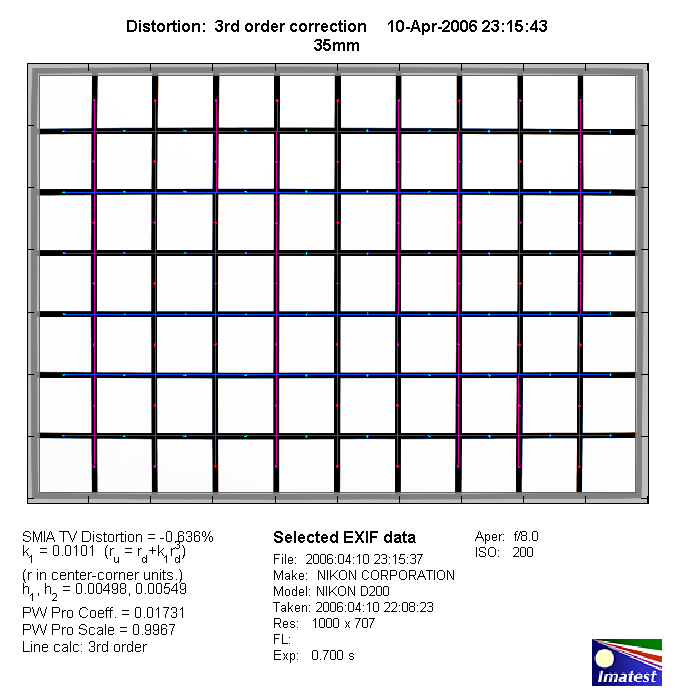|
Page 2 of 2

Distortion
The lens shows a small amount of barrel distortion on DX cameras. This is hardly an issue in real-world images.

The chart above has a real-world size of about 120x80cm.
Vignetting
Being a FX lens, the Nikkor profits from the sweet spot advantage on DX cameras, but nonetheless shows visible light fall-off towards the corners wide open. Stopping down reduces vignetting to a negligible level, though.

MTF (resolution)
The image center shows very good resolution wide open already. Stopped down to f/2.8 and beyond, the resolution is excellent until diffraction reduces sharpness again at f/11.
The borders and corners are a very different story though. Wide open, the lens is very soft here and needs to be stopped down to f/5.6 or f/8 to deliver good to very good resolution across the whole frame.
The lens showed some focus shift when stopping down (residual spherical aberration).
Please note that the MTF results are not directly comparable across the different systems!
Below is a simplified summary of the formal findings. The chart shows line widths per picture height (LW/PH) which can be taken as a measure for sharpness.
If you want to know more about the MTF50 figures you may check out the corresponding Imatest Explanations

Chromatic Aberrations (CAs)
Chromatic aberrations (color shadows at harsh contrast transitions) are generally moderate, but show an interesting behaviour: from around one pixel wide open they decrease to just a half pixel at f/4, but increase again towards smaller apertures, reaching around 1.4 pixels at f/11.
However, CAs can easily be corrected in software or by the camera itself (most modern Nikon DSLRs remove CAs themselves if you shoot JPGs).

Bokeh
The quality of the bokeh (out-of-focus blur) is a little disappointing. Good news first: in front of the focal plane the bokeh shows very pleasant blur. However, for a wide angle lens this is probably a completely irrelevant property in the field. In the transition zone and behind the focal plane the lens produces double images and nervous blur.
Background highlights are troubled by very pronounced outlining wide open, stopping down helps to reduce this issue. However, from f/5.6 onwards the straight aperture blades form polygon highlights instead of circles.

Bokeh Fringing
Bokeh fringing is a common issue with relatively fast glass. It's visible as halos of different colors in out-of-focus areas - magenta (red + blue) in front of the focus point and green beyond.
The AF-D 35/2.0 shows a moderate amount of bokeh fringing at large aperture settings, stopping down helps to reduce the issue to a negligible degree.
In addition, these shots also show the focus shift when stopping down and demonstrate a lack of contrast and sharpness wide open (the latter being emphasized on short subject distances).
Sample Images
You can find some sample images taken with the Nikon D3x in our Nikon FX review of the lens.
VerdictThe Nikkor AF-D 35mm f/2.0 left a mixed impression. Center sharpness at most apertures is as good as you'd expect it from a prime lens, however the borders and corners clearly fall behind. With large apertures, the results are simply disappointing. To be fair, though: stopped down to f/5.6 or f/8 the lens delivers very good sharpness here, too.
Both distortions and CAs are moderate and not really an issue in the field, on the other hand vignetting is a bit on the high side at large apertures. Some bokeh fringing is visible wide open, but that's to be expected from a fast prime. A more serious issue for such a fast lens is the rather poor quality of its bokeh.
The build quality is on a high level. Not quite up to pro standards, but nothing to complain about either.
In summary, there's some light but also quite some shadow. The lens certainly can deliver very good results if you're aware of its limitations and issues and able to work around them. However, there is a dedicated DX lens available that delivers better performance at a lower price: the Nikkor AF-S DX 35/1.8. Its only disadvantage compared to the AF-D 35/2.0 is that it can not work as a single lens solution in a dual use scenario with both DX and FX cameras.
|